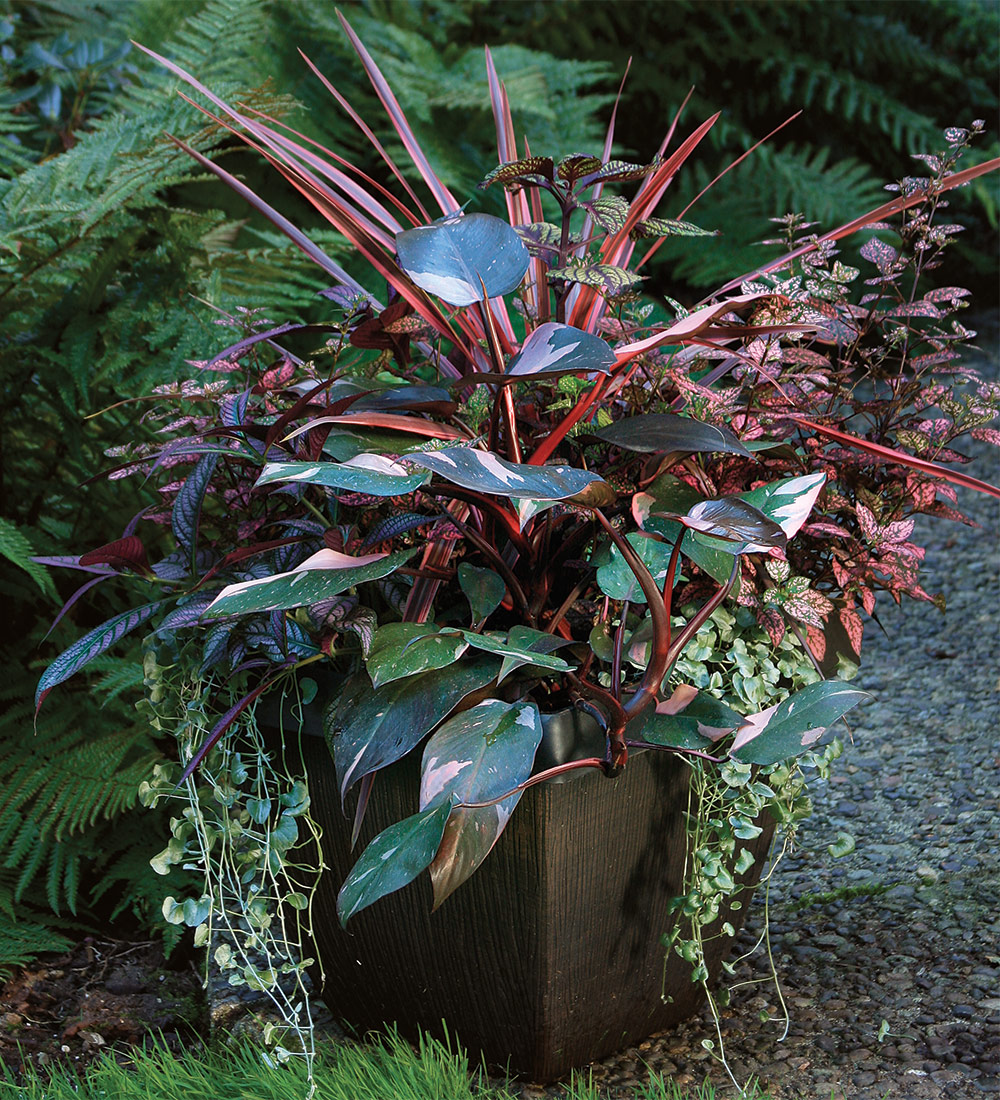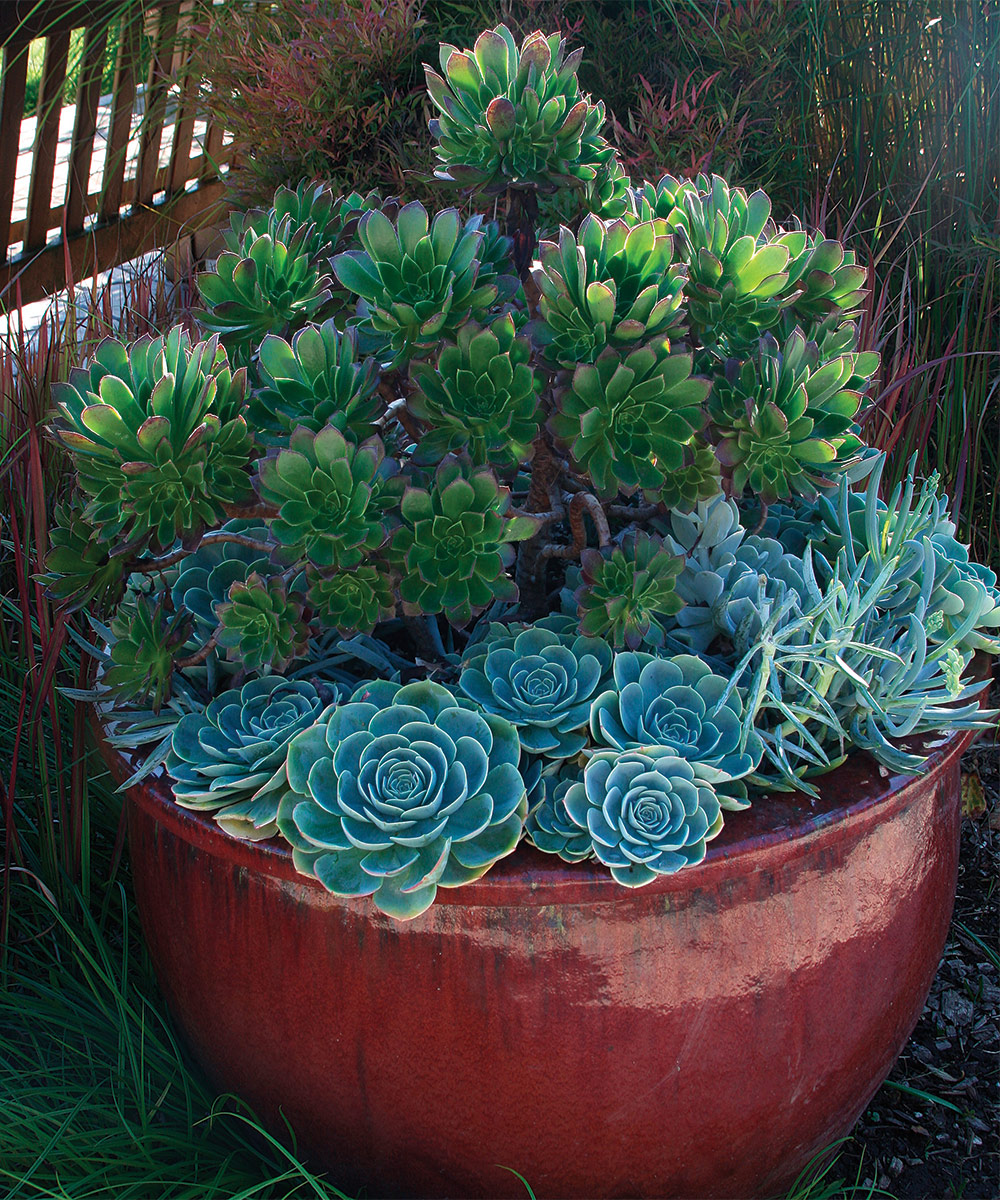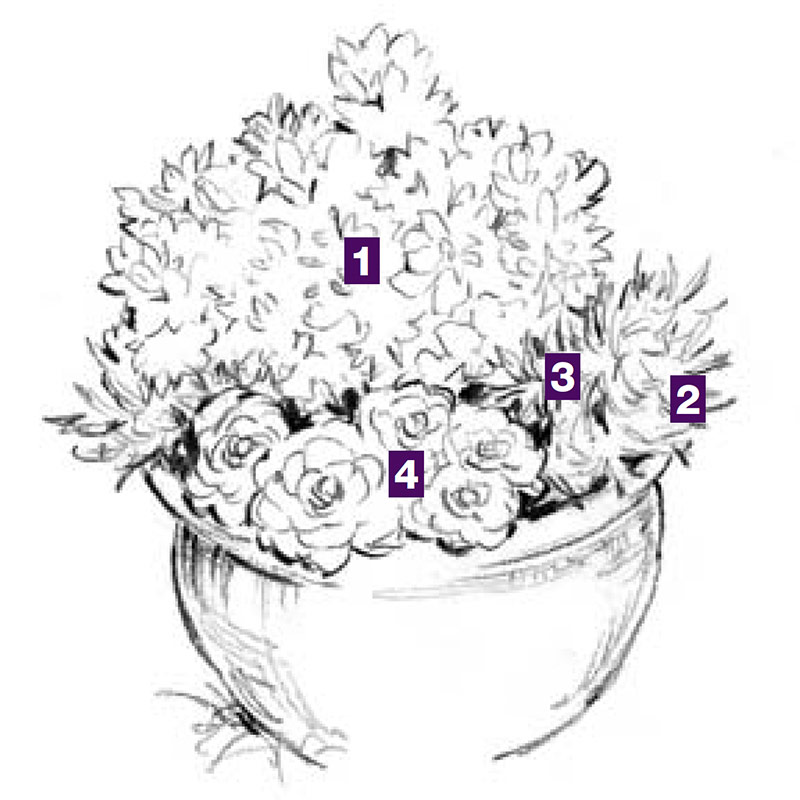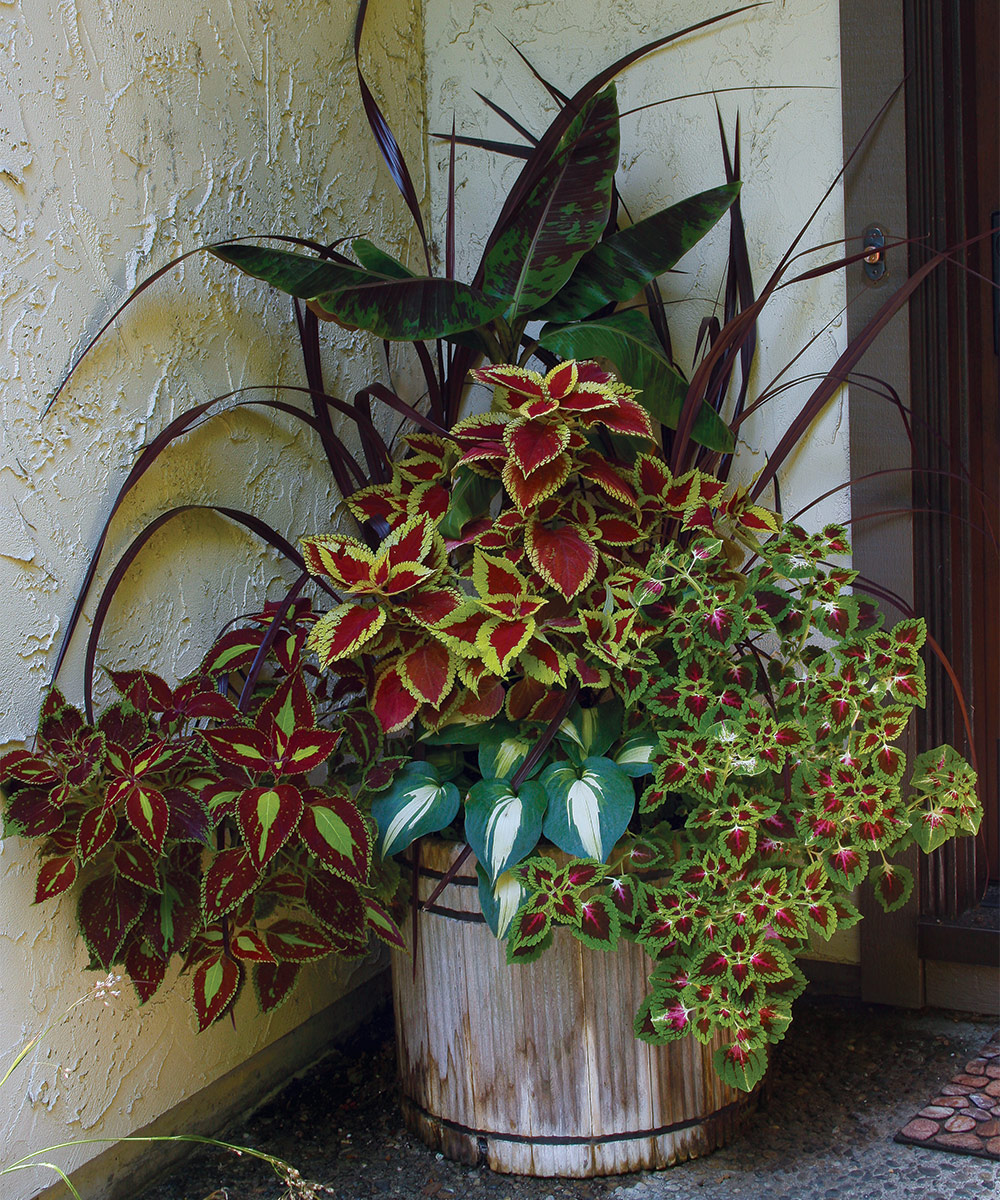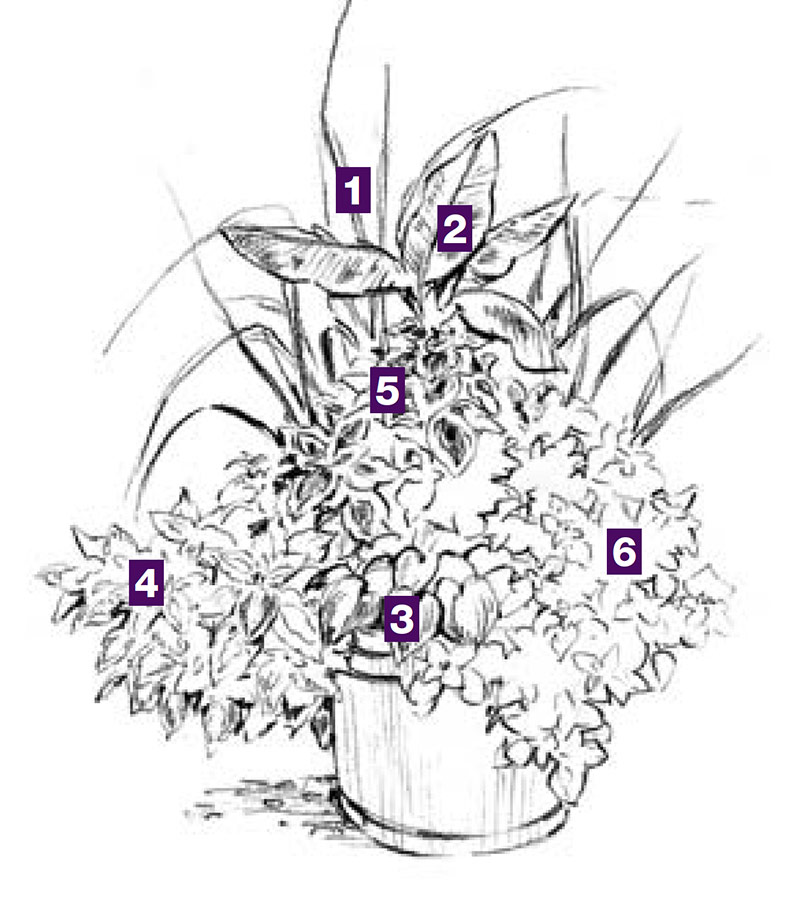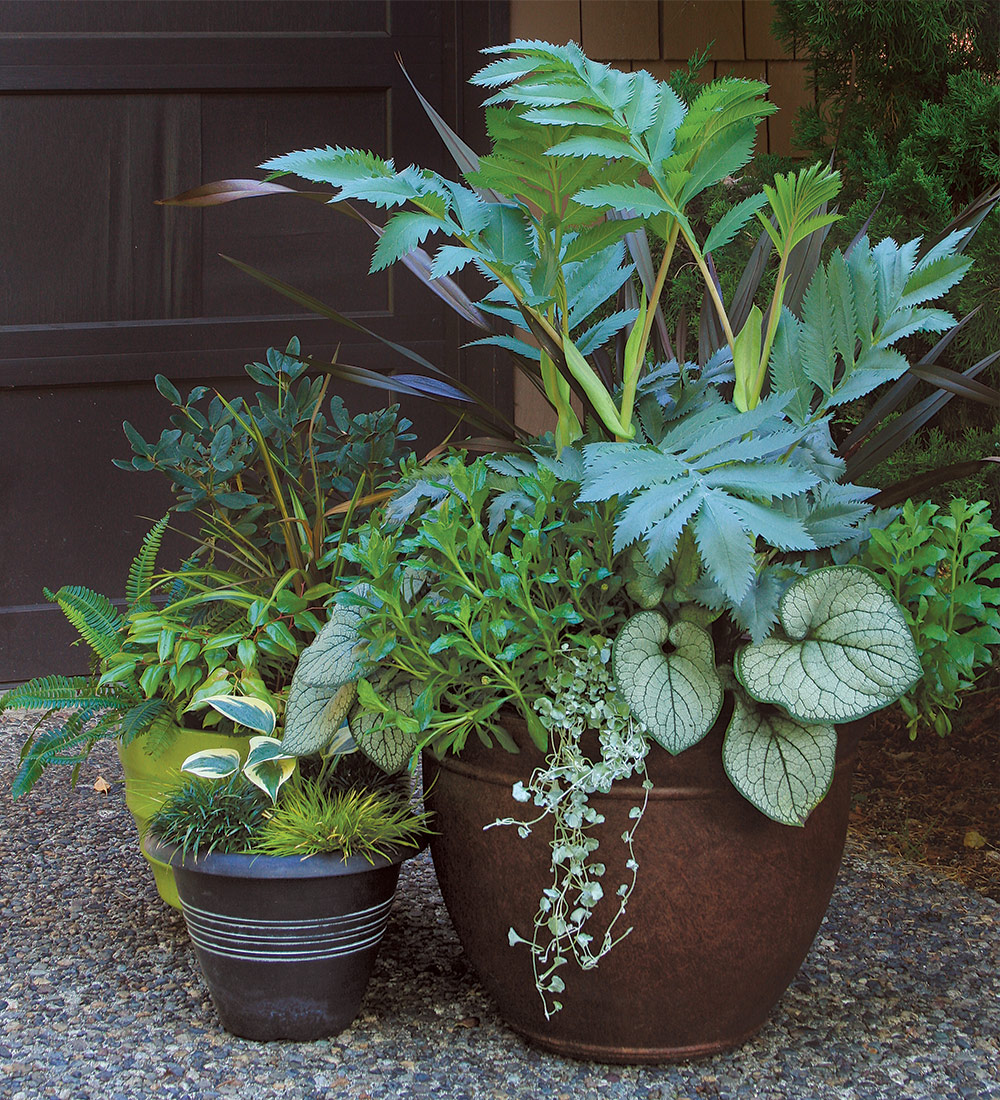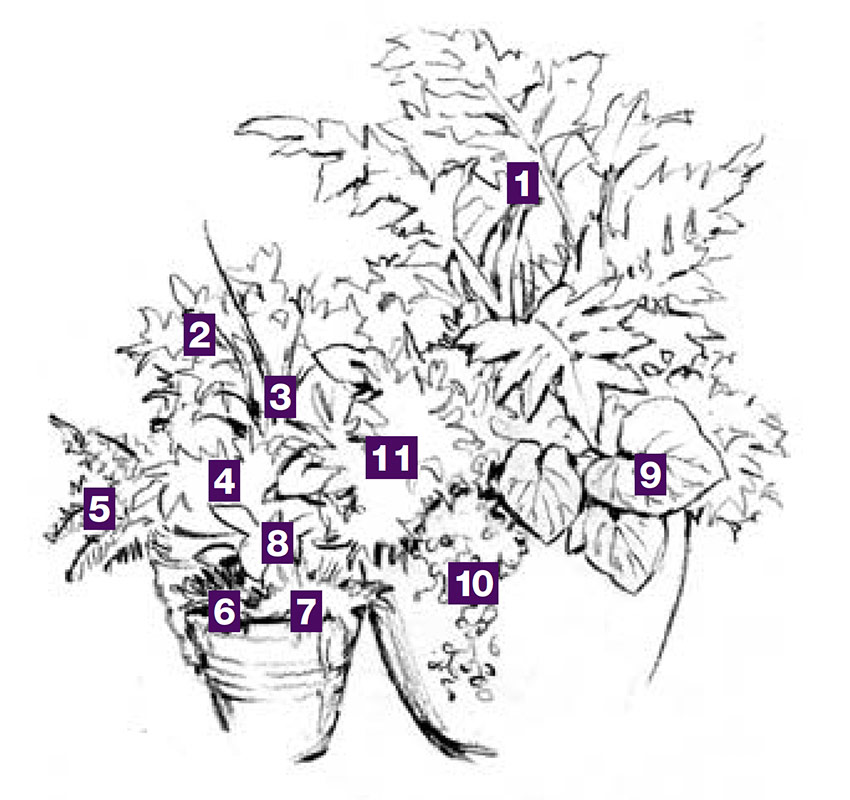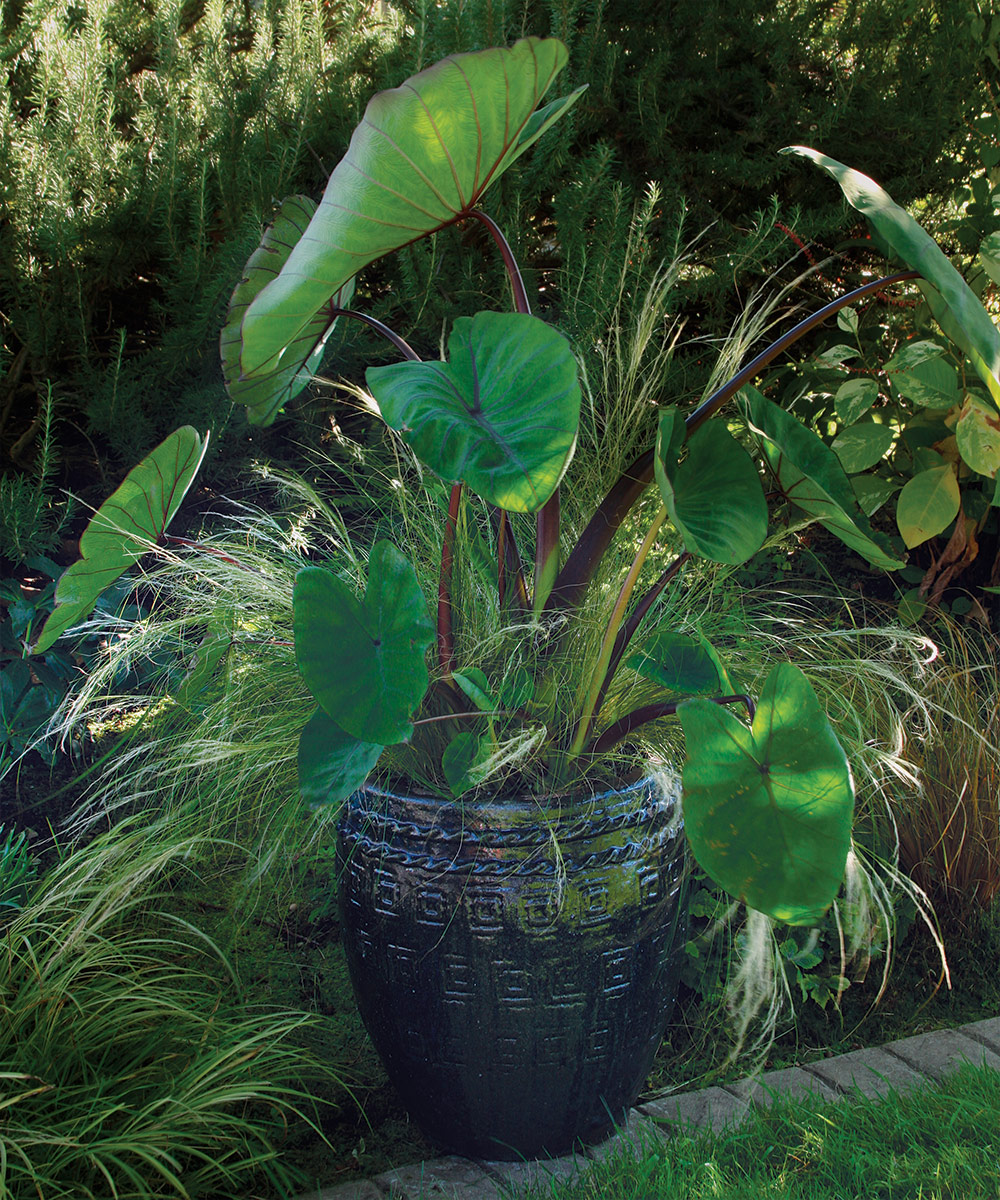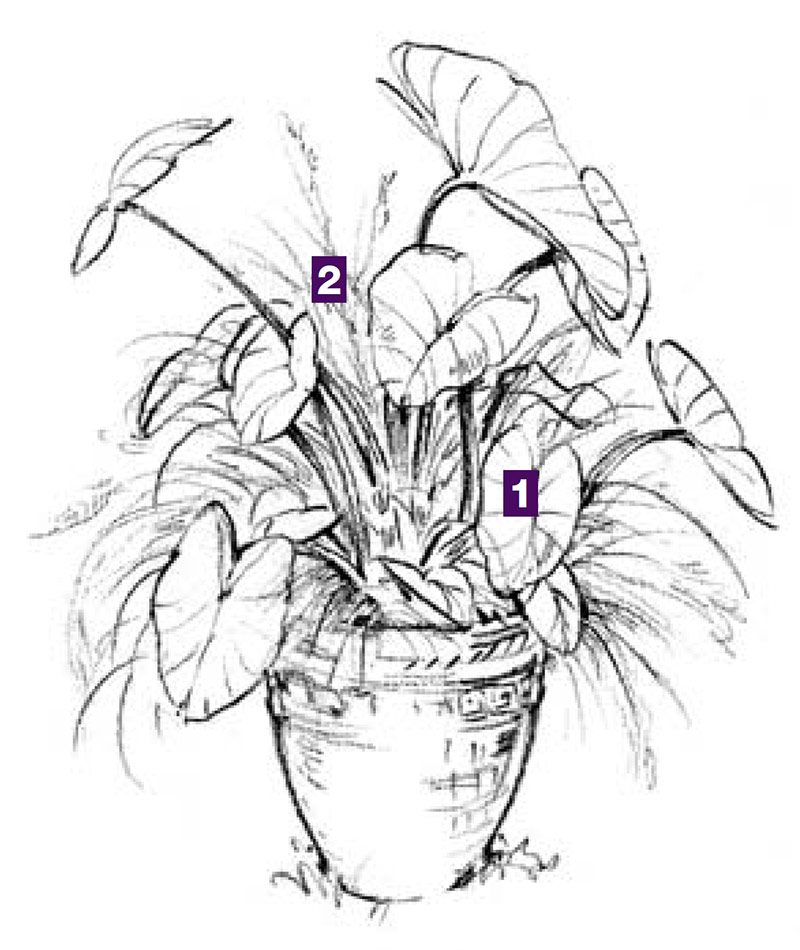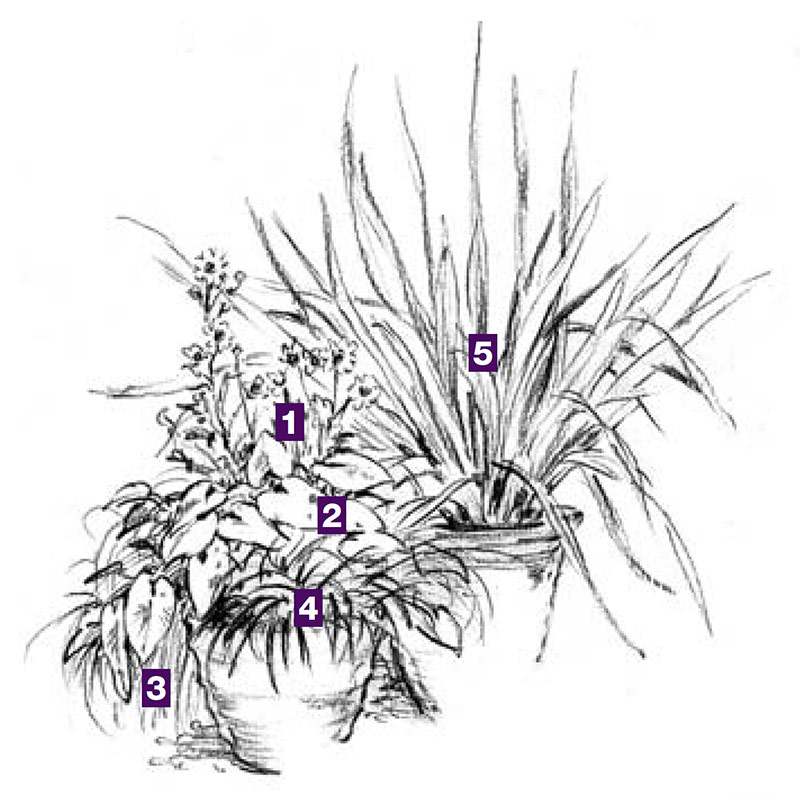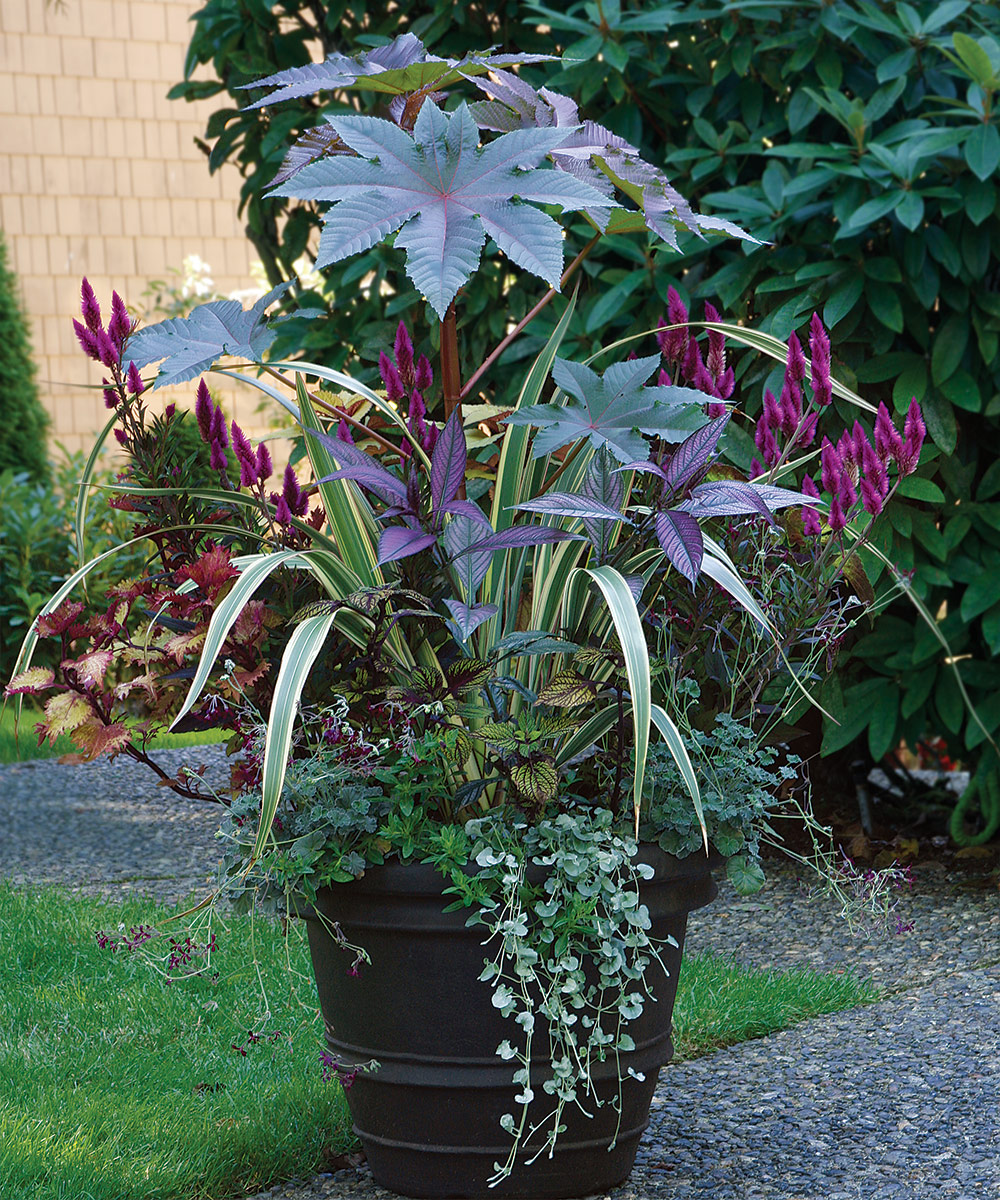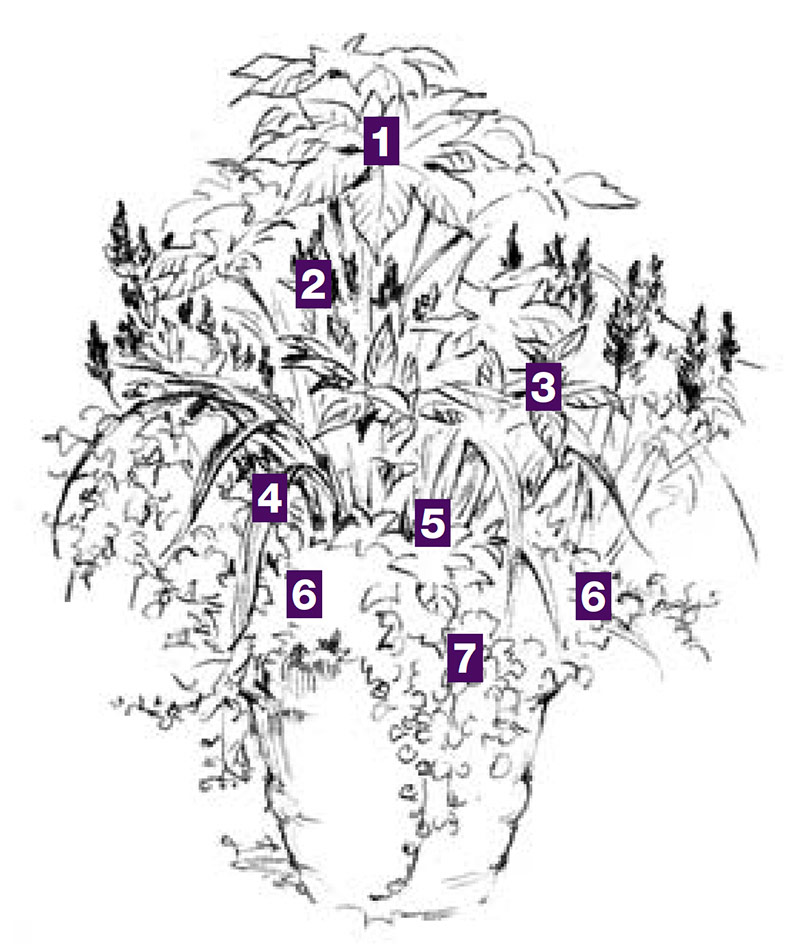Summer season is the season all gardeners await. The intense solar and heat climate sign the beginning of the showiest time of yr, and nowhere is that this pleasure extra evident than with container gardening. Backyard shops are overflowing with vegetation and pots in each coloration, dimension, fashion, and form. Whether or not you lean towards tropicals or are captivated with succulents, summer time is the season to point out off your abilities. To get you began, we’ve assembled just a few designs by Riz Reyes of Seattle and Julie Chai of San Francisco (for Julie’s designs, see half 1 of this text). We invite you to faucet into their creativity—and to develop upon their suggestions—to make this your finest container season but.
Restricted coloration, excessive impression
A number of of the vegetation on this container have related textures and shapes, however variegation is what units them aside. Quite than mixing right into a bland mass, the vegetation’ markings separate them sufficient to make the combination dynamic. A vertical accent and an total pink theme make the design cohesive.
- ‘Cherry Sensation’ cordyline (Cordyline australis ‘Cherry Sensation’, Zones 7–11)
- ‘Pink Princess’ philodendron (Philodendron erubescens ‘Pink Princess’, Zone 13)
- ‘Fishnet Stockings’ coleus (Solenostemon scutellarioides ‘Fishnet Stockings’, Zones 12–13)
- Persian protect (Strobilanthes dyerianus, Zones 9–11)
- Polka dot plant (Hypoestes phyllostachya cv., Zones 10–11)
- ‘Silver Falls’ dichondra (Dichondra argentea ‘Silver Falls’, Zones 10–11)
Encourage vegetation to play effectively collectively
Low-growing succulents permit their bigger counterparts to take heart stage on this easy planting. Whereas a tree aeonium can stand by itself, the echeveria and blue chalk sticks add further curiosity and variety. The mix is made much more hanging by the deep purple container that picks up on the ideas of the aeonium and contrasts fantastically with blue.
- Tree aeonium (Aeonium arboreum var. atropurpureum, Zones 9–11)
- Blue chalk sticks (Senecio mandraliscae, Zones 10–11)
- ‘Topsy Turvy’ echeveria (Echeveria runyonii ‘Topsy Turvy’, Zones 9–11)
- Blue rose echeveria (Echeveria imbricata, Zones 9–11)
Make a shady nook pop
If it weren’t for the vegetation on this container, the chilly white stucco wall would dominate this shady entry with its starkness. As a substitute, it serves as the right backdrop for a dense association of types and textures. A chartreuse theme weaving by way of the coleus and a spot of white variegation within the hosta give the realm further pop.
- Pageant Grass™ cordyline (Cordyline ‘JURred’, Zones 8–11)
- Blood banana (Musa acuminata ‘Zebrina’, Zones 10–11)
- ‘Dream Queen’ hosta (Hosta ‘Dream Queen’, Zones 3–9)
- ‘Saturn’ coleus (Solenostemon scutellarioides ‘Saturn’, Zones 12–13)
- ‘Defiance’ coleus (S. scutellarioides ‘Defiance’, Zones 12–13)
- ‘Odalisque’ coleus (S. scutellarioides ‘Odalisque’, Zones 12–13)
Tip
Considered deadheading of flowers and pruning fast-growing foliage encourage slower growers to catch up, leading to a cohesive container planting as a substitute of a bedraggled or misshapen one. That is very true for coleus; nothing will make a container messy sooner than forgetting to deadhead coleus flowers.
Silver is heart stage
The success of this dramatic trio lies in artistic coloration repetition and textural selection. Though the silver honey bush is clearly the star of the present, it shares the highlight with the shimmering leaves of brunnera and dichondra. The adjoining pots make a terrific supporting solid, selecting up on each the colours and textures of the vegetation at heart stage.
- ‘Antonow’s Blue’ honey bush (Melianthus main ‘Antonow’s Blue’, Zones 8–11)
- ‘Rosevallon’ rhododendron (Rhododendron neriiflorum ‘Rosevallon’, Zones 7–9)
- ‘Cha Cha’ cordyline (Cordyline ‘Cha Cha’, Zones 9–11)
- Keiskei fetterbush (Leucothoe keiskei, Zones 6–8)
- Deer fern (Blechnum spicant, Zones 5–8)
- Dwarf mondo grass (Ophiopogon japonicus ‘Nanus’, Zones 7–10)
- Dwarf golden candy flag (Acorus gramineus ‘Minimus Aureus’, Zones 6–9)
- ‘Blue Ivory’ hosta (Hosta ‘Blue Ivory’, Zones 3–9)
- ‘Sea Coronary heart’ brunnera (Brunnera macrophylla ‘Sea Coronary heart’, Zones 3–7)
- ‘Silver Falls’ dichondra (Dichondra argentea ‘Silver Falls’, Zones 10–11)
- ‘Whirligig’ African daisy (Osteospermum ‘Whirligig’, annual)
Easy is stately
The various shades of inexperienced and the starkly contrasting textures of the elephant’s ear and Mexican feather grass are all this planter wants. However by inserting the 2 in a contrasting darkish navy planter that picks up on the blue-purple within the leaves of the elephant’s ear, this easy association makes a convincing assertion.
- ‘Blue Hawaii’ elephant’s ear (Colocasia esculenta* ‘Blue Hawaii’, Zones 8–11)
- Mexican feather grass (Nassella tenuissima, Zones 7–11)
Tip
Eager for simplicity? Do not forget that a single plant—resembling agave, elephant’s ear, or phormium—is all you want to make an announcement if it’s planted in the correct pot. When utilizing only one plant, you should definitely choose a container that enhances, relatively than competes with, the plant.
One-flower surprise
Chartreuse and black are a hanging mixture—the spots and variegation within the elephant’s ear echo the black mondo grass—and the sedge and New Zealand flax match the entrance pot to a tee. However add a jolt of blood purple dahlia with darkish foliage to the center and this pairing is immediately reworked into a luxurious, dynamic show.
- Mystic Surprise dahlia (Dahlia ‘Velvet’, Zones 9–11)
- ‘Mojito’ elephant’s ear (Colocasia esculenta* ‘Mojito’, Zones 8–11)
- ‘Frosted Curls’ sedge (Carex ‘Frosted Curls’, Zones 7–9)
- Black mondo grass (Ophiopogon planiscapus ‘Nigrescens’, Zones 6–11)
- ‘Yellow Wave’ New Zealand flax (Phormium ‘Yellow Wave’, Zones 8–11)
Each plant has its place
The towering castor bean offers a cover beneath which plenty of vegetation flourish. The look turns into much more dramatic with the addition of a spiky ‘Tricolor’ New Zealand flax within the heart, however it’s then subdued by the contrasting flowers and foliage that decide up the colours within the castor bean, making a full-circle expertise.
- ‘Carmencita’ castor bean (Ricinus communis ‘Carmencita’, annual)
- ‘Intenz’ cockscomb (Celosia ‘Intenz’, annual)
- Persian protect (Strobilanthes dyerianus, Zones 9–11)
- ‘Tricolor’ New Zealand flax (Phormium cookianum subsp. hookeri ‘Tricolor’, Zones 8–11)
- ‘Fishnet Stockings’ coleus (Solenostemon scutellarioides ‘Fishnet Stockings’, Zones 12–13)
- South African geranium (Pelargonium sidoides, Zones 9–11)
- ‘Silver Falls’ dichondra (Dichondra argentea ‘Silver Falls’, Zones 10–11)
*These vegetation are thought-about invasive in some areas. Please examine invasiveplantatlas.org or your state’s record of invasive vegetation for extra info.
Photographs: Lynn Felici-Gallant
Illustrations: Elara Tanguy
